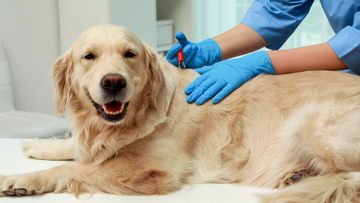Spring: The “blooming time” for parasites
Spring is coming, leaves and buds are sprouting, and the warm rays of sunshine invite our furry friends to take long walks in the woods and meadows. With the blooming vegetation and the mild temperatures, annoying pests are also awakening from their hibernation: ravenous and eager for new "hosts." Fleas, ticks, mites, and worms are causing dogs a lot of trouble, as they feed at the expense of our four-legged friends' health.
Ticks love mild, spring-like temperatures. This is precisely why ticks are "active" from spring through fall, repeatedly posing a threat to dogs and their owners. Once attached, a tick takes a few days before detaching. Dog skin can react with itching and swelling. This can even cause scarring or hair loss.
They often severely weaken the defenses of the defenseless host animal, making it easy for viruses and bacteria to invade. Severe itching, widespread hair loss, intestinal or coat problems are common consequences that can be traced back to parasite infestation and a weakened immune system. Our furry friends also often suffer from nutritional deficiencies caused by the parasites' deprivation of nutrients. Furthermore, fleas and ticks don't spare us either. They often migrate from animals to humans, making life difficult for us, as some dog parasites are also infectious to humans. Furthermore, fleas, for example, are not picky about where they sleep and feel just as comfortable on dog cushions as on our TV couches.
Worms, ticks, ectoparasites: What consequences they can have for dogs
An animal's health can be severely affected by a worm or tick infestation. This must be prevented.
-
itching
-
constipation
-
Vomiting and diarrhea
-
Deficiency symptoms and nutrient deprivation
-
Worm belly
-
Loss of appetite
-
Weight loss
Diseases such as anaplasmosis, ehrlichiosis and babesiosis are also infections with a potentially chronic course that can make life difficult for dogs.
Remove ticks correctly
-
Grasp the tick as close to the dog's skin as possible, using a tick hook or tweezers
-
Turn and pull slowly
-
Be careful not to crush the tick
-
Disinfect tick bites
-
After the tick has been successfully removed, it can be rendered harmless in alcohol.
How do I get a tick out of my dog?
To prevent this from happening in the first place, it is necessary to take preventative measures in good time so that you are not confronted with these pests or unpleasant symptoms later on.
IMUN Dog® Para from Nikolaus Nature provides dogs with a long-lasting, preventative treatment. It works holistically and effectively against fleas, ticks, worms, etc., making it a natural and therefore extremely effective "weapon" in the fight against parasites. This dietary supplement for dogs, made from purely natural ingredients, supports our four-legged friends in successfully fighting off parasites, viruses, and bacteria. High bioavailability and absorption characterize this tasty specialty, made in Austria, and make it an unbeatable alternative to conventional supplements. Adding IMUN Dog® Para daily to the dog's food as a natural "prophylactic" is significantly easier than treating complex infections.

|











